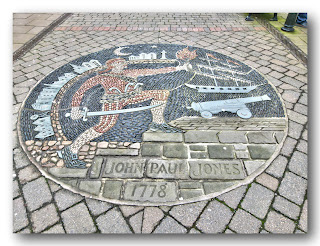As you can see the road surface is still stone sets, and opposite this place is a pedestrianised area.
There is a prominent Bandstand, and the first of the artistic attractions, two bronze statues of local fishing lads from the 1960's
The figures are very well executed with a very high level of detail, and well worth a close look and photograph.
Walk past then into the main street and look back to enjoy the "cobble mural" around the bollards
Every 25 yards or so there are circular mosaics (pebbles of course) set in the roadway, they illustrate the history of Whitehaven in many ways.This one for instance commemorated the raid by the American Navy led by John Paul Jones, he intended to set fire to the fishing fleet, but this failed due to heavy rain, and the attraction of the local public houses!
This one has a Foxhunting theme
Whitehaven used to be a major mining area, this one commemorated those unfortunate enough to work in the local mines
The tower is a local feature, but I didn't see any Dragons while we were there!
This one appears to be either a coat of arms or a reference to Hare Coursing
This mosaic is of the Slaving shipKing George, built in Whitehaven in 1803, whose third mate was John Paul Jones (1747–92), later the naval hero of the American War of Independence, who subsequently expressed his aversion to the slave trade.
The ship was wrecked in the Azores on the island of Fayal where it put in to repair leaks, and was wrecked in a gale allegedly with "great loss of life"
And finally this fine coat of arms. These are just a sample of the examples of this artform that seems to be everywhere in Whitehaven, but the onset of rain had us heading for shelter!
We had a good day despite the weather.











1 comment:
I understood the two figures under the bandstand to be 'tars'...sailors, probably from the nineteenth century, when Whitehaven was something of a port and that specific location is where the tars without a ship would congregate to find work. It was a site of a labour pool gathering where ship owners and captains could find workers for their ships.
Post a Comment